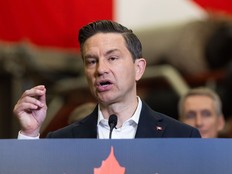Toronto Metropolitan University’s new med school built to serve the underserved
"If we can ensure that our ability to have many of our learners come through our healthcare system, work with our community partners and really help improve the critical shortage that exists within our regions, that would be a huge benefit.”

Article content
Toronto Metropolitan University (TMU) is opening its doors to the first new medical school in the Greater Toronto Area (GTA) in over a century this fall.
The school’s goal is to usher in a new generation of learning in underserved communities with a special focus on physician retention. The reality is that many communities in Canada lack access to primary care and millions of Canadians are without a family doctor.
Recommended Videos
Communities across Ontario, and those found in the Peel Region, are of particular focus for TMU’s programs.
“There’s a huge need to have the physicians of the future be committed towards being community-oriented and also focus on the needs of the system as a whole, not being siloed within one area,” said Dr. Jobin Varughese, a family physician in Brampton and interim Assistant Dean of Primary Care Education at TUMU. “We’re aiming to have a community approach and really embedding ourselves within the community.”
Addressing disparities in health care in Ontario
The Peel region is home to a diverse group of people, and within that group, many belong to marginalized communities that face delayed care, poor health comes, and a lack of access to primary physicians. TMU’s new school aims to address this through different practices.
According to Dr. Varughese, approaching education in a culturally sensitive way is one of their main tenets.
“Brampton’s such an important melting pot and we have a lot of different knowledge,” he said. “There’s a lot of importance to bring together what typically is thought of as Western medicine or conventional medicine and bringing together the known entities in the way that we can do things.”
They are also putting a significant focus on innovation and technology that will enhance how students learn and interact with their educators so that when these students are ready to look after patients, they’ve covered all bases and can meet “the medical needs of our communities,” including mental health and elder care.
“There’s a huge issue with mental health, and we want to focus on ensuring that our learners are able to graduate and really focus on that as well,” said Dr. Varughese. “As well as the elder care and the older adults, and ensure that they are understanding that the entire amount of work that’s going to be necessary for care of the older adult is really understood and built into the way they learn.”
Curating success through fine-tuned equitable admissions
According to Dr. Dominick Shelton, the interim Assistant Dean for Admissions and Recruitment, the school’s first call for admission applications was “highly competitive” and garnered over 6,400 applications. With only 94 seats, the approach to finding individuals who align with the objective is a challenging one.
Of those who have received acceptance letters, 90 per cent reside in Ontario, with 38 per cent of them hailing from the Peel Region.
“We recognize the fact that there are underrepresented groups within medicine, and we have set out to address that, and the important reason why we’re addressing that is because we want to serve the population and we want our medical school and the people that we accept and graduate to reflect the population being served,” said Dr. Shelton.
The goal was to create a school platform that provides people who grew up in these communities, who have regional ties to these areas, and those who have a passion for helping their communities, the chance to become physicians who make a difference at home.
“I think it’s important to remember that the school is intentionally situated in Brampton,” said Dr. Varughese. “We recognize … having a culturally diverse and fast-growing city allows us to also aim for the urgent needs that exist within that system. Our healthcare systems around this area are some of the busiest because of the high complexity and high acuity of care here. Because of that, we are actively working to address the shortages that exist.”
The school’s admission pathways fall into three categories: the Indigenous pathway, the Black pathway, and the equity-deserving admissions pathway.
“Data clearly shows that Indigenous and Blacks are underrepresented in medicine, and particularly in relation to the population,” said Dr. Shelton. “The equity-deserving group is addressing other cohorts of people who are underrepresented, and it’s everywhere from lower socioeconomic to disability and other groups that we feel are equity deserving.”
To ensure they’re looking at the community through a non-filtered lens, they worked closely with local communities to create pathways that genuinely reflect the disparities, such as those with the Peel District School Board and the Black Health Hub.
Dr. Varughese notes that it was about “finding the different niches that we can where we can provide a service to in our community while also ensuring that we can learn with and from them.”
Getting an acceptance at TMU requires students to be passionate, involved, and academically successful. It isn’t just about getting good grades and fitting in with a certain demographic.
There are various facets of the admissions process that sway the recruiters in one direction or the other, such as a student’s additional volunteer work, passion for the community, advocacy work, and more.
“Excellence and equity are not mutually exclusive,” said Dr. Shelton. “They very much can coexist, and that is who we are targeting … the best of the best and at the same time, addressing underrepresentation.”
Putting a special focus on physician retention
TMU’s programs aren’t just training the next generation of medical professionals to work in Peel or even Ontario. These students will be given a unique opportunity to learn innovative and future-forward approaches to providing care that can be applied in medical work across the globe.
That said, physician retention is of great importance and something that TMU has continued to integrate into their overall structure.
“By no means are we saying that you have to be from Brampton and Peel Region and the surrounding area to enter our medical school, but it is favourably looked upon in the application process,” said Dr. Shelton.
By placing a special emphasis on local students, those in charge of admissions are aware that the community connection, one of the pillars they established when developing the school, remains intact. Another aspect of learning is placing students, regardless of where they hail from, into the community during the learning process, which will also develop into community connections.
“We’re immersing them into the community, and we’re going to show them the joys of being a family physician or primary care physician in other areas working in the community,” said Dr. Shelton.
Dr. Varughese notes that those who have applied are likely already part of the community, or at the very least, interested in becoming a part of the community, which helps with physician retention.
“A lot of times, the students that will likely be coming to us are the ones who are driven or are interested in the mission that we have, which is to really help with that health disparity,” he said. “We’re going to be bringing in a certain type of learner that will want to build something.”
While the school offers training programs for various specialties in medicine, it’s especially focused on family practice because that’s where the greatest needs are in underrepresented communities.
“I think the biggest thing is, if we can ensure that our ability to have many of our learners come through our healthcare system, work with our community partners and really help improve the critical shortage that exists within our regions, that would be a huge benefit,” said Dr. Varughese.










